| A | B |
|---|
| The enzyme that catalyzes the elongation of new DNA at a replication fork by the addition of nucleotides to the existing chain is called _____. | DNA polymerase (the orange molecules in the picture below) p314,  |
| _____ is a linking enzyme essential for DNA replication. It catalyzes the covalent bonding of the 3' end of a new DNA fragment to the 5' end of a growing chain. Specifically, it bonds the sugar from one nucleotide to the phosphate of another nucleotide. | DNA ligase p316,  |
| The change in genotype and phenotype due to the assimilation of external DNA by a cell is called ____. | transformation (This use of the word transformation should not be confused with the conversion of a normal animal cell to a cancerous one, discussed in section 12.3) p306 |
| A short segment of DNA synthesized on a template strand during DNA replication which is joined to other short segments to form the lagging strand is called a(n) _____. | Okazaki fragment p315,  |
| The process of copying a cell's DNA is called _______. | DNA replication p311,  |
| The shape of a DNA molecule is referred to as a(n) _____. | double helix p309,  |
| The new continuous complementary DNA strand synthesized along the template strand in the mandatory 5' to 3' direction. | leading strand pp315-316,  |
| A virus that infects bacteria is called a(n) _____. | bacteriophage p306,  |
| The discontinuously synthesized DNA strand that elongates in a direction away from the replication fork is called the ______. | lagging strand p315,  |
The picture below shows a(n) _____.,  | bacteriophage (this virus infects bacteria only) p306,  |
What type of bonds (represented by the pink dotted lines) hold the bases of complementary DNA together?,  | hydrogen bonds p310,  |
The letter A is pointing to the ______.,  | leading strand pp315-316,  |
The letter B is pointing to the ______.,  | lagging strand pp315-316,  |
The letter C is pointing to the ______.,  | Okazaki fragments p315,  |
The letter D is pointing to ______.,  | DNA polymerase p315,  |
The letter F is pointing to ______.,  | DNA ligase (notice that it is catalyzing the bonding of the sugar end of one Okazaki fragment to the phosphate end of the other Okazaki fragment) p316,  |
| The nitrogenous base adenine always bonds to ______ in a DNA molecule. | thymine p310 |
| The nitrogenous base cytosine always bonds to ______ in a DNA molecule. | guanine p310 |
| Alfred Hershey and Martha Chase used radioactive ______ to label the proteins in the T2 bacteriophage. | sulfur (They used sulfur because it is found in some amino acids that make up protein, but is never found in the nucleotides that make up DNA) pp307&308,  |
| Alfred Hershey and Martha Chase used radioactive ______ to label the DNA in the T2 bacteriophage. | phosphorus (They used phosphorus because it is found in the nucleotides that make up DNA, but is never found in the amino acids that make up proteins) pp307&308,  |
What is this a picture of and what is the name of the technique used to produce it?,  | DNA, X-ray crystallography p309,  |
| What was the name(s) of the scientist who first published a paper describing the correct structure of DNA in 1953? | Watson and Crick (They, along with Maurice Wilkins, were awarded the Nobel Prize for their work on determining the structure of DNA. The prize was awarded in 1962. Rosalind Franklin had passed away in 1958 and was therefore ineligible for the prize. Many people believe that Rosalind Franklin did not get the credit she deserved while Watson and Crick got too much.) pp305&310 |
Which model of DNA replication is correct and what is the model called?,  | B) semiconservative model (was worked out by Meselson and Stahl using radioactive nitrogen markers to trace the path of the parent DNA strands) pp311&312,  |
| A permanent change in a DNA sequence is called a(n) ______. | mutation p318 |
| DNA wraps around ________ to form chromatin. | histone proteins p320, 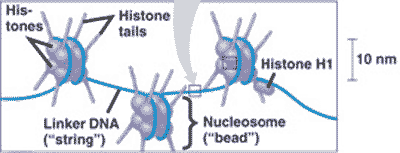 |
| The process of making proteins inside cells is called ______. | protein synthesis (For some reason, this book has all but stopped using the term "protein synthesis" although it is mentioned on page 325. Instead, they describe what is commonly referred to as protein synthesis as "Getting from DNA to protein") p328 |
| In which organelle is DNA located in? | nucleus (in prokaryotic organisms, DNA is located in the nucleoid region of the cytoplasm since they don't have a nucleus) p328 |
Which type of nucleic acid can't leave the nucleus?, 
| DNA p328 |
| On which organelle are proteins made? | ribosomes p328, 
|
| Where are ribosomes located? | out in the cytoplasm p328, 
|
| The process of making a strand of RNA in the nucleus is called _____. | transcription p328 |
Which nucleotide do you find in RNA but not DNA?, 
| uracil p328 |
| Uracil bonds to across from ______. | adenine p328 |
| The process of using the code on m-RNA to make a long chain of amino acids in the correct order to form a protein is called _____. | translation p328 |
| Which type of molecule brings amino acids to the site of protein synthesis? | transfer RNA (t-RNA) p337 |
| Which molecule attaches to a ribosome and serves as a code for putting amino acids together? | messenger RNA (m-RNA) p328 and section 17.4 |
How many nucleotides are needed to code for 1 amino acid?, 
| 3 p329 |
| How many different types of amino acids are used to make proteins? | 20 pp326&330 |
Each set of 3 nucleotides on a strand of m-RNA are called a _____., 
| codon p330 |
| How many nucleotides are found at the bottom of a molecule of t-RNA and are involved with bonding to m-RNA? | 3 p329 |
| How many amino acids are found attached to a molecule of t-RNA? | 1 p337 |
A change in the sequence of nucleotides in a molecule of DNA will cause a ____., 
| mutation p344 |
| Mutations that are harmful are usually weeded out by ______. | natural selection p259 |
| Mutations in a gene that are helpful usually become part of the gene pool as a new ____. | allele (An allele is a different form of a gene) p259 |
Which amino acid would the codon sequence AGU call for?,  | Serine p330,  |
| Which enzyme is required for transcription? | RNA Polymerase (remember, you are making RNA during transcription) p331 |
| What are the three types of RNA that have major roles in protein synthesis? | m-RNA (messenger RNA), t-RNA (transfer RNA) and r-RNA (ribosomal RNA) p339 |
| Where does transcription occur in eukaryotic cells? | In the nucleus p329 |
| Where does translation occur? | Out in the cytoplasm on ribosomes p328 |
| Proteins are made out of ____. | amino acids pp326-328 |
| Which type of molecule is a codon found on? | m-RNA (the term codon is also sometimes used for the DNA base triplet along the non-template strand. These codons are complementary to the template strand and thus identical to the m-RNA codon other than the substitution of uracil for thymine in the m-RNA) p330 |
| If a recently manufactured protein has a primary structure that is 1000 amino acids long, how many nucleotides long was the coding part of the mRNA molecule used as the instructions for that protein? | 3000 (remember, it takes 3 nucleotides to code for each amino acid) p330 |
| A mutation involving the addition of one or more nucleotide pairs to a gene is called a(n) _______. | insertion p345 |
| A noncoding, intervening sequence within a eukaryotic gene is called a(n) ______. | intron (the part of the mRNA that is transcribed from DNA introns, but is cut out before the mRNA exits the nucleus, is also called an intron) p335 |
Which amino acid is represented by the shape with the question mark in the picture below? Use the chart to find the answer.,  | Serine p330,  |
| The removal of the noncoding portions (introns) of the RNA molecule after initial synthesis and the subsequent attachment of the remaining coding portions (exons) to each other is called ______. | RNA splicing p334 |
| A(n) _____ mutation occurs when the number of nucleotides inserted or deleted is NOT a multiple of three, resulting in the improper grouping of the following nucleotides into codons. | frameshift p346 |
| Which type of mutations can lead to frameshift mutations? | insertions or deletions that are not in multiples of three pp345&346 |
| The DNA strand that temporarily binds RNA nucleotides during transcription is called the _________. | template strand p329 |
| Where are ribosomes constructed and what are they composed of? | nucleolus, r-RNA and protein (the large and small subunits of the ribosome are constructed in the nucleolus but never come together until they start the process of transcription in the cytoplasm, after which, they come apart again) p339,  |
| A chemical or physical agent that interacts with DNA and causes a mutation is called a(n) ______. | mutagen p346 |
| A specific nucleotide sequence in DNA that binds RNA polymerase and indicates where to start transcribing RNA is called the _____. | promoter p332,  |
| The enzyme that links together the growing chain of ribonucleotides during transcription is called _____. | RNA polymerase pp331-333, 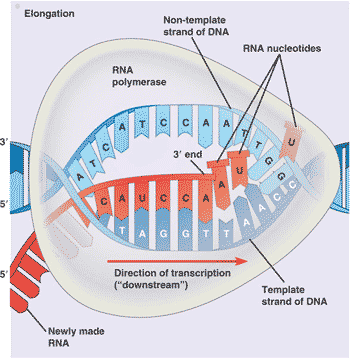 |
| A point mutation in which one or more nucleotides pairs are lost from a gene is called a(n) ______. | deletion (deletions can also happen at the chromosomal level in which case they are called chromosomal deletions) p345 |
| Modification of RNA before it leaves the nucleus in eukaryotes is called _____. | RNA processing p334,  |
| A change in a gene at a single nucleotide pair. | point mutation p344 |
| The coding region of a eukaryotic gene; when transcribed into mRNA, it is the coding part of mRNA that leaves the nucleus. | exon p335,  |
Which process belongs in the darker red box in the picture below?,  | transcription p329,  |
Which process belongs in the pink box in the picture below?,  | RNA processing p329,  |
Which process belongs in the light blue box in the picture below?,  | translation p329,  |
What is "A" pointing to in the picture below?, 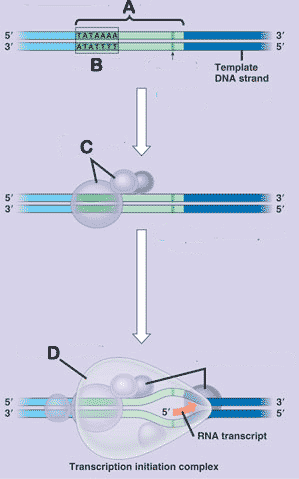 | Promoter p333,  |
What is "D" pointing to in the picture below?,  | RNA polymerase p333,  |
What is "B" pointing to in the picture below?, 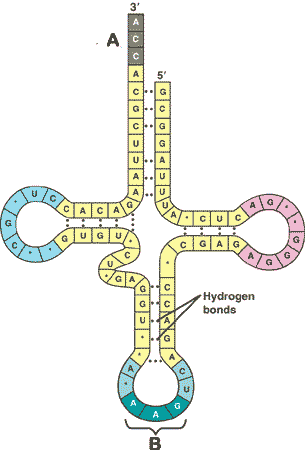 | anticodon of tRNA p338,  |
| The concept that genetic information flows from _____ to _____ to _______ was dubbed the "central dogma" by Francis Crick in 1956. | DNA --> RNA --> Protein p328 |
| In prokaryotic DNA, a sequence of nucleotides near the start of an operon to which an active repressor can attach, preventing the attachment of RNA polymerase to the promoter (which prevents transcription). | operator (the yellow part of the operon below) p352,  |
| A promoter, an operator, and the genes they control make up a(n) _______. | operon p352,  |
| In both prokaryotes and eukaryotes, gene expression is most often regulated at the stage of _______. | transcription p351,  |
| DNA wraps around ________ to form chromatin. | histone proteins p320,  |
| During development of multicellular organisms, cells undergo a process of becoming specialized in form and function in a process called ________. | cell differentiation (this involves activating certain genes and permanently silencing others, such as genes for liver proteins in a pancreas cell) p367 |
| What affect does the acetylation of histone tails have on the ability of DNA to be transcribed? | makes it easier (because the acetyl group -COCH3 neutralizes the positive charge of the histone protein, loosening the grip of the histone on the negatively charged DNA. It also loosens their attraction to neighboring nucleosomes) p357, 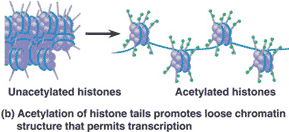 |
| What affect does the methylation of histone tails have on the ability of DNA to be transcribed? | makes it harder p357 |
| Segments of non-coding DNA that help regulate transcription by binding certain proteins are called ______. | control elements p358,  |
| The Epstein-Barr virus, Human papillomavirus (HPV) and HTLV-1 virus have all been identified as ____ viruses that cause ______. | tumor viruses, cancer p377 |
| Cancer causing genes are called _____. | oncogenes (the normal version of these cellular genes are called proto-oncogenes. They are usually involved with normal stimulation of cell growth and division. These genes are ones that commonly mutate to form oncogenes) p373 |
| ______ code for proteins that stimulate normal cell growth and division, but can be turned into a cancer-causing gene by mutations. | proto-oncogenes p373 |
| An individual ______ an oncogene or mutant allele of a tumor-suppressor gene is one step closer to accumulating the necessary mutations for cancer to develop by the _____ model of cancer development. | inheriting, multistep p376, 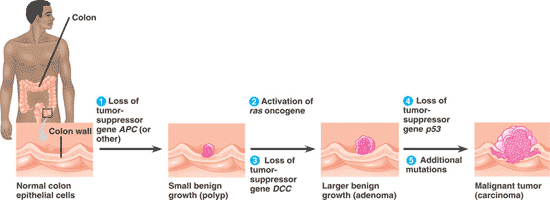 |
What is "A" pointing to in the picture below?, 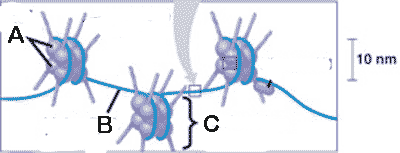 | histone proteins p357,  |
| A gene found in viri or as a mutated form of normal gene that is normally involved with regulating the cell cycle, but now is involved in triggering cancerous characteristics. | oncogene p373 |
| The guardian angel of the genome, this gene is expressed when a cell's DNA is damaged. Its product is a transcription factor that transcribes proteins whose job it is to keep mutated cells from dividing or help repair damaged DNA. | p53 gene p376, 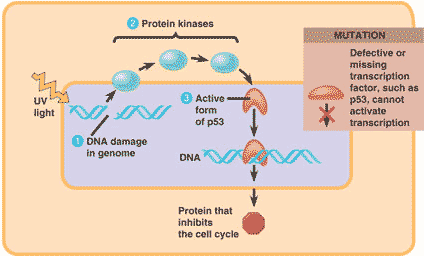 |
| A segment of noncoding DNA that helps regulate transcription of a gene by binding proteins called transcription factors. | control element p358,  |
| Expression of different sets of genes by cells with the same genome is called _____. | differential gene expression p356 |
| A normal cellular gene corresponding to an oncogene; a gene with the potential to cause cancer, but that requires some alteration to become an oncogene. | proto-oncogene p373 |
| HPV, the human papillovavirus, is a virus that is often sexually transmitted and is associated with _____ in females and ____ in males. | cervical cancer, genital warts (This is a type of virus with many different forms. It is usually transmitted sexually and can lie dormant without producing symptoms for years. Yet it can still be transmitted while asymptomatic. The strains that cause genital warts (in men and women) are not the same ones that increase the risk of cervical cancer. It is estimated that around 3/4ths of older adults carry this virus. Young adults are now able to get vaccinated against the most common and dangerous forms of the virus) p377 |
| The end of an animal that is near the head is called the _______ end. | anterior p370 |
| The end of an animal that is near the tail is called the _______ end. | posterior p370 |
| The belly of an animal is said to be on the ______ side of the body. | ventral p370 |
| The back of an animal is said to be on the ______ side of the body. | dorsal (Think about the dorsal fin of a shark sticking out of the water) p370 |
| Maternal substances in the egg that influence the course of early development are called ___________. | cytoplasmic determinants p367 |
| In Drosophila, bicoid mRNA is an example of a __________. | cytoplasmic determinant (The term "morphogen" can also apply because the bicoid mRNA forms a gradient that helps establish the developmental axes. The term "Bicoid" by itself refers to the protein product of bicoid m-RNA that gets translated once the egg is fertilized. Bicoid is also a morphogen, but is not a cytoplasmic determinant, because it did not enter the egg from the mother's cells), 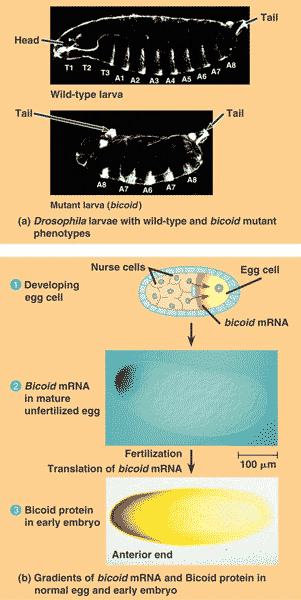 |
| Any of the master regulatory genes that control placement and spatial organization of body parts in animals, plants, and fungi by controlling the developmental fate of groups of cells is called a(n) ______. | homeotic gene p371 ,G-17 |
| The products of _____ genes are cytoplasmic determinants. These include proteins and/or RNA that are produced by the mother and enter the egg but don't spread out evenly in the egg. The different concentration of these substances in the egg lead to the establishment of the axes in the developing embryo. | maternal effect genes (a.k.a. - egg polarity genes) p371 |
| The products of maternal effect genes are ______. These include proteins and/or RNA that are produced by the mother and enter the egg but don't spread out evenly in the egg. The different concentration of these substances in the egg lead to the establishment of the axes in the developing embryo. | cytoplasmic determinants p371 |
| The name of the late stages of HIV infection, defined by a specific reduction of T cells and the appearance of characteristic secondary infections. | AIDS (acquired immunodeficiency syndrome) p388 |
| The name of the virus that can lead to AIDS is called ____. | HIV (human immunodeficiency virus) p388,  |
| ______ is an enzyme encoded by some certain viri (retroviri) that use RNA as a template for DNA synthesis. | Reverse transcriptase (The HIV virus pictured below is a retrovirus. Notice the reverse transcriptase and how it is used once in the host cell) p389,  |
| A(n) _______ is a membrane that surrounds the capsid of some viri. | viral envelope (The picture below shows how viri acquire a viral envelope from the membrane of the host with extra components coded for by the virus) pp383&387, 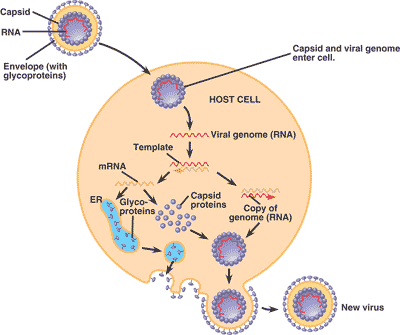 |
| A(n) _____ is a virus that infects bacteria. | bacteriophage (can also be called "phage") p383,  |
| Viral DNA that inserts into the host genome of eukaryotic cells and never leaves is called a(n) _____. | provirus (Notice the provirus in this diagram of HIV infection. A provirus, unlike prophage DNA, never leaves the hosts genome. Prophage is also specific to viral DNA that is encorporated into bacterial genomes. The provirus is transcribed within the nucleus to direct the building of new viral proteins and the mRNA that is transcribed can also become the new virus's genome itself) pp389&390,  |
| A phage replication cycle in which the viral genome becomes incorporated into the bacterial host chromosome as a prophage and does not kill the host. | lysogenic cycle (the phage will eventually be triggered to enter the lytic cycle and kill the host cell) p386,  |
| An RNA virus that reproduces by transcribing its RNA into DNA and then inserting the DNA into a cellular chromosome. | retrovirus (these include some cancer-causing viri and HIV pictured below) p388,  |
| A(n) ______ is a phage genome that has been inserted into a specific site on the bacterial chromosome. | prophage (This type of DNA can lie basically dormant for long periods of time while bacteria continue to reproduce. At some point, the prophage DNA will be triggered to create new phages and enter the lytic phase of its reproduction cycle. Although dormant as far as not killing the host, prophage DNA can cause the bacterial cell to make toxins, which is the case with bacterial diseases such as diptheria, botulism, and scarlet fever. The bacteria themselves would be much less harmful if it were not for the prophage DNA that they are infected with) p387,  |
| A(n) _____ is an infectious form of mis-shaped protein that may increase in number by converting related proteins to mis-shaped protein. | prion (Prions are responsible for brain wasting diseases in animals such as mad cow disease and Creutzfeldt-Jacob disease in humans) p394, 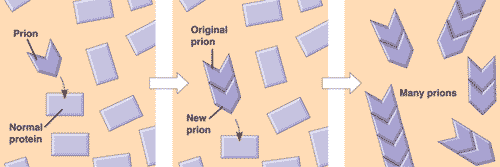 |
| What is responsible for brain wasting diseases in animals such as mad cow disease and Creutzfeldt-Jacob disease in humans? | Prions (mis-shaped proteins that are nearly impossible to destroy and cause other proteins to become mis-shaped) p393,  |
| A(n) _____ is a plant pathogen composed of naked circular RNA only several hundred nucleotides long. | viroid (A viroid does not encode proteins, but can replicate in host cells using host cell enzymes. These small RNA molecules seem to cause errors in the regulatory systems that control plant growth) p393 |
| A(n) ______ is a harmless variant or derivation of a pathogen that stimulates a host immune system to mount defenses against the pathogen. | vaccine p391 |
| A disease causing agent is called a(n) _______. | pathogen G-26 |
| The protein shell that encloses the viral genome is called the _____. | capsid p383,  |
| A type of viral (phage) replication cycle resulting in the release of new phages by lysis (and death) of the host cell. | lytic cycle p385,  |
| To lyse something means to _____. | break it open p385 |
Which type of phage lifecycle is pictured on the right?,  | lysogenic p386,  |
Which type of phage lifecycle is pictured on the left?,  | lytic p386,  |
| A(n) ______ is an infectious particle consisting of a nucleic acid surrounded by a protein coat. | virus pp381&382 |
| A virus is an infectious particle consisting of a(n) ______ surrounded by a(n) ______. | nucleic acid, protein coat (the nucleic acid can be either DNA or RNA) pp381&382 |
| What does "in vitro" mean? | in a test tube (Or other type of laboratory container. The opposite of in vitro is "in vivo" which means "in the living") p396 |
| DNA in which nucleotide sequences are combined from two different sources - often different species - is called _______. | recombinant DNA p396,  |
| The direct manipulation of genes for practical purposes is called _____. | genetic engineering p396,  |
| The manipulation of organisms or their components to make useful products is called ______. | biotechnology p396,  |
| Making multiple copies of DNA fragments that code for a specific polypeptide is called _______. | gene cloning p397,  |
| A common approach to cloning a gene involves splicing the gene of interest into a(n) ____ _____ , then reinserting it back into the ________ which will then reproduce, making many copies of the gene. | bacterial plasmid, bacterium p397,  |
| Enzymes that cut DNA molecules in a limited number of specific locations are called _______. | restriction enzymes p398,  |
| Restriction fragments (Segments of DNA that were produced using restriction enzymes) can be permanently sealed by an enzyme called _______ which catalyzes the formation of covalent bonds between the sugar at the end of one fragment and the phosphate group at the end of the other fragment. | DNA ligase p398,  |
| A method of quickly producing a lot of DNA copies in vitro from a small amount of original DNA is called ______. | PCR (stands for polymerase chain reactions) p405, 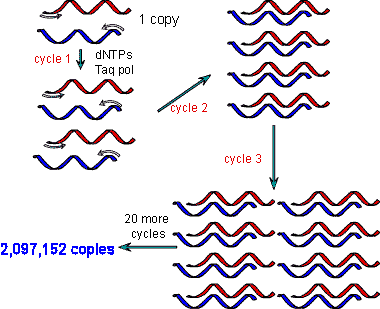 |
| A technique for separating DNA or protein based on size and charge is called _______. | gel electrophoresis p405,  |
| An individual's unique collection of DNA restriction fragments, detected by electrophoresis and nucleic acid probes. | Genetic profile (Many people still refer to it as a "DNA fingerprint.") p420, 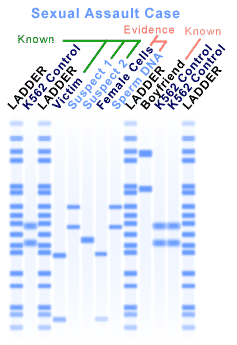 |
| The alteration of genes of a person afflicted with a genetic disease is called ______. | gene therapy p418,  |
| A single-strand end of a double-stranded DNA restriction fragment is called the ______. | sticky end p398,  |
| A degradative enzyme that recognizes and cuts up DNA (including that of certain phages) that is foreign to a bacterium. | restriction enzyme p398,  |
| A lineage of genetically identical individuals or cells is called a(n) _____. | clone G-7 |
The picture below shows the _____ of the victim and several suspects in a sexual assault case. The banding patterns produced by using a restriction enzyme and comparing the RFLP's of each person can be used to solve the case.,  | genetic profiles (Many people still refer to it as "DNA fingerprints.") p420,  |
According to the DNA analysis of the crime scene shown below, who committed the crime?,  | Suspect #1 (notice how suspect #1's RFLP's match the sperm sample taken from the crime scene.) p420,  |
Which laboratory technique is shown below?,  | gel electrophoresis p405,  |
What is the name of the process shown below?,  | gene therapy p418,  |
What is "A" in the picture below?,  | restriction site p398,  |
What is "B" in the picture below?,  | restriction enzyme p398,  |
What is "C" in the picture below?,  | DNA ligase p398,  |
| Small circular DNA molecules that replicate separately from the main bacterial chromosome are called _____. | plasmids p397,  |
| A common way to insert foreign DNA into a bacterial cell is to mix the bacterial cells into a solution containing the foreign DNA fragments (or foreign DNA spliced into a plasmid). Under suitable experimental conditions, the foreign DNA will pass through the cell wall and cell membrane to enter the cytosol of the the bacterium. This process is called _____. | transformation p400 |
| Any relatively unspecialized cell that can produce, during a single division, one identical daughter cell and one more specialized daughter cell that can undergo further differentiation. | stem cell p415 & G-33 |
| A stem cell with the ability to differentiate into any type of cell that makes up an organism is said to be ______. | totipotent p412 |
| A stem cell with the ability to differentiate into many, but not all of the types of cells that makes up an organism, is said to be ______. | pluripotent p416 |
| Another name for pluripotent stem cells is ___ stem cells. The only kind of stem cells that are totipotent (able to differentiate into becoming any kind of cell) are ____ stem cells (although major advances have recently been made in reprogramming already differentiated cells to becoming totipotent). | adult stem cells, embryonic stem cells (a.k.a. ES cells) p416 |
| Transgenic "pharm" mammals, such as goats, can be engineered to produce human proteins in their ___. | milk (Human proteins produced in transgenic "pharm" animals for use in humans may differ in some ways from the naturally produced human proteins, possibly because of subtle differences in protein modification. Therefore, such proteins must be tested very carefully to ensure that they (or contaminants from the "pharm" animals) will not cause allergic reactions or other adverse effects in patients who receive them) pp419&420 |
| Any of the master regulatory genes that control placement and spatial organization of body parts in animals, plants, and fungi by controlling the developmental fate of groups of cells. | homeotic gene p445, G-17 |
| A 180-nucleotide sequence within homeotic genes and some other developmental genes that is widely conserved in animals. Related sequences occur in plants and yeasts. | homeobox p445, G-17 |
| The study of whole sets of genes and their interactions is called ____. | genomics p426 |
| The ______ was a project started in 1990 with the goal of sequencing the entire human genome. It was largely completed by 2003. | Human Genome Project p427 |
| The study of whole protein sets encoded by genomes. | proteomics p431 |
| Both prokaryotes and eukaryotes have stretches of DNA that can move from one location to another within the genome. These stretches are known as ______. | transposable elements (sometimes called "jumping genes") pp434&435 |
| During the process called ____, a transposable element moves from one site in a cell's DNA to a different target site by a type of recombination process. | transposition p435 |
| Former genes that have accumulated mutations over a long period of time and no longer produce functional proteins. | pseudogenes p434 |
| The more similar in sequence the genes and genomes of two species are, the more _____________ those species are in their evolutionary history. | closely related p442 |
| What does "evo-devo" stand for? | "Evo-devo" stands for evolutionary developmental biology. p445 |
| Animal genes containing the 180-nucleotide sequence called the homeobox, many of them homeotic genes that directly control the identity of body parts, or other genes containing the homeobox that are associated with development such as the egg-polarity gene bicoid, several segmentation genes, and in a master regulatory gene for eye development. | HOX genes p445 |